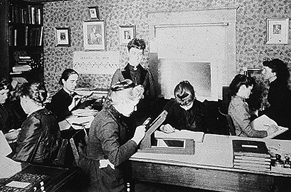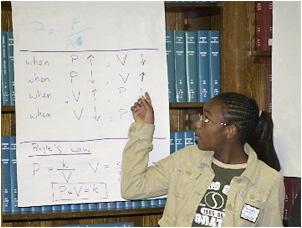 |
 |
 |
 |
 |
 |
 |
 |
 |
 |
|
KICP Workshops & Events
|
KICP Workshops, 2005 Why So Few Women in Science? Defining the Problem and Taking Action May 20, 2005 | BSLC Auditorium room 109  The purpose of the symposium is twofold: first, to educate and update the university community, including faculty, administrators and students, on the issues and research surrounding the problem of the severe under-representation of women in science (in particular the physical sciences), and second, to motivate concrete actions to address this problem at the University of Chicago. Since the audience will be mainly scientists, the general themes of the symposium will echo the approach most scientists are familiar with in attacking new problems: Defining the Problem: Current statistics on women in science Understanding the Detector: Research on gender bias, both in the wider culture and within the academic community Selection Effects and Data Analysis: Understanding the climate in academic science Moving Ahead: Progress Report on the NSF Advance Program at the University of Michigan The symposium will conclude with a panel discussion by the four speakers, with a focus on suggestions for where we go from here. Speakers Include: Rachel Ivie AIP co-author of the recent AIP report on Women in Physics and Astronomy Kimberlee Shauman UC, Davis Prof. of Sociology and co-author of "Women in Science : Career Processes and Outcomes" (with Yu Xie, University of Michigan) Londa Schiebinger Stanford Professor of History of Science in the Department of History and the Barbara D. Finberg Director of the Institute on Women and Gender. Schiebinger is author of "The Mind Has No Sex?", "Women in the Origins of Modern Science" (Harvard University press, 1989); the prize-winning "Nature's Body: Gender in the Making of Modern Science" (Beacon Press, 1993; Rutgers University Press, 2004); "Has Feminism Changed Science?" (Harvard University Press, 1999). Tim McKay Associate Professor of Physics Associate Chair for Undergraduate Education University of Michigan. Organizing Committee: Evalyn Gates (Chair), Sean Carroll, Heinrich Jaeger, Eileen Sheu. Related Links: KICP Members: Sean M. Carroll Visualization of Astrophysical Data: Bringing Together Science, Art, and Education May 25 - 27, 2005 Website The visualization of real astrophysical data sets is a powerful tool for communicating science to the public and for teaching. The confluence of high quality data sets such as SDSS & WMAP, advances in computational techniques, and the continued march of Moore's law has enabled the use of stunningly beautiful and scientifically accurate images, animations, and interactives in a variety of settings (e.g. TV programs, museums, websites, digital planetaria, magazines, & undergraduate classrooms). Two dimensional, three dimensional, and hyper-dimensional (e.g. color coded 3D data) representations convey large amounts of information in a visceral fashion that can inform both experts and the public. As the data and techniques have progressed the boundaries between art and science have begun to blur and move towards research. This workshop will bring together astrophysicists, visualizers, and educators to discuss the current status and to debate the future direction of astronomical visualization as a tool for research, education, and public outreach. Organizers: Randy Landsberg, Josh Frieman, Andrew Hamilton (CU Boulder), Andrey Kravtsov, Mark SubbaRao, & Alex Szalay (JHU). Read more >> Related Links: KICP Members: Joshua A. Frieman; Andrey V. Kravtsov; Randall H. Landsberg; Mark Subbarao The Nature of Light, Yerkes Summer Institute August 6 - 12, 2005 | Yerkes Observatory in Williams Bay, WI  In honor of the World Year of Physics and the 100th anniversary of Einstein's "miraculous year", the theme of YSI 2005 was "The Nature of Light". Twenty-six (26) Space Explorers, twenty (20) instructors, and fifty (50) parents and siblings participated in this week long, residential, immersion experience. The institute reinforced concepts from the 2004-05 Saturday laboratory sessions, which explored the basics of light and its wave particle duality. A full six (6) hours was devoted to each day laboratory with twelve (12) additional hours allotted for extended investigations by small reporting groups. "The Photoelectric Effect" explored the quantum nature of light with physical model to demystify it and direct measurements of the photoelectric effect. "The Speed of Light" was a clever use of a television as a very fast detector that allowed the students to measure c to within twenty percent. "The Doppler Effect" explored the Doppler effect qualitatively with a buzzer on a string and then quantitatively by using a radar gun and a sound spectral analysis program to determine the frequency shift and its relation to speed. Evening laboratories included a study of quasar line broadening, related to the Doppler shift, the use of a CCD detector that was related to the photoelectric effect and finally an examination of supernova as standard candles. Instructors: Charles Brass, Lisa Blair, Kyle Cudworth, Tom Downes, Bill Fisher, Robert Friedman, Walter Glogowski, Sarah Hansen, Vivian Hoette, Dragan Huterer, Rick Kessler, Rich Kron, Randy Landsberg, Douglas Rudd, Chaz Shapiro, Matthew Sharp, Ivo Seitenzahl, Reid Sherman, John Vaillancourt, Phil Wisecup , Brian Wilhite. Related Links: KICP Members: Dragan Huterer; Richard Kessler; Richard G. Kron; Randall H. Landsberg KICP Students: Tom Downes; Sarah M. Hansen; Douglas H. Rudd; Charles Shapiro; Matthew Sharp "Big Bang & Beyond, 21st Century Cosmology", Cosmology Short Course September 23 - 25, 2005 | Chicago, IL Website This three day course will take participants to the frontiers of current cosmological research and provide them with the necessary tools to bring the excitement of discovery back to their home institutions. By bringing together the researchers making the discoveries with planetarium/museum/science center staff, who interact daily with the public, this course will help energize the presentation of cosmology in informal educational settings. This intensive course will establish the framework of standard Big-Bang cosmology and provide insights into recent discoveries into its inner workings. We will follow the evolution of the universe from its earliest moments, about 14 billion years ago when it was a soup of elementary particles, until the present day when it is a tangled web of filaments consisting of galaxies and clusters of galaxies. The observational foundations of our understanding of the universe include measurements of the temperature anisotropy in the cosmic microwave background, the spatial distribution of galaxies and clusters of galaxies, and the expansion history of the universe. On the theoretical side, we will focus on cosmic acceleration at the two ends of time. We will review the predictions of cosmic inflation, acceleration during the short moment of time after the Big Bang, and see how to test them with current and future observations. Read more >> Related Links: KICP Members: John E. Carlstrom; Sean M. Carroll; Juan I. Collar; Joshua A. Frieman; Wayne Hu; Dragan Huterer; Andrey V. Kravtsov; Randall H. Landsberg; Stephan S. Meyer; Angela V. Olinto; Clement L. Pryke; Mark Subbarao; Bruce D. Winstein New Views of the Universe, Kavli Institute Inaugural Symposium in memory of David Schramm December 8 - 13, 2005 Website | Online Materials Organizers: Angela V. Olinto, Clarence L. Chang, Joshua A. Frieman, Dragan Huterer, Stephan S. Meyer, Clement L. Pryke, Bruce D. Winstein, Scott P. Wakely, John E. Carlstrom, Juan I. Collar, Sean M. Carroll, James W. Cronin, Christopher Gordon, Wayne Hu, Andrey V. Kravtsov, Randall H. Landsberg, Brian C. Odom, Hiranya V. Peiris, Michael S. Turner, Dorothea Samtleben, Yong-Seon Song, Monica Valluri, Xiaomin Wang, Risa H. Wechsler, Tokonatsu Yamamoto, Andrew R. Zentner, Simon P. Swordy Cosmological discoveries of the past 10 years have revolutionized our view of the Universe. The KICP Inaugural Symposium New Views of the Universe will focus on a broad range of topics from particle physics and cosmology of the early universe to structure formation in the local Universe. The Symposium aims to bring together cosmologists, particle physicists, astrophysicists, and astronomers from around the world to discuss the current status and the future of theory, experiments, and observations at the particle physics - cosmology interface. The Symposium will also honor the memory of David Schramm who was a pioneer of cosmology and particle astrophysics. Read more >> Related Links: KICP Members: John E. Carlstrom; Sean M. Carroll; Clarence L. Chang; Juan I. Collar; James W. Cronin; Joshua A. Frieman; Christopher Gordon; Wayne Hu; Dragan Huterer; Andrey V. Kravtsov; Randall H. Landsberg; Stephan S. Meyer; Brian C. Odom; Angela V. Olinto; Hiranya V. Peiris; Clement L. Pryke; Dorothea Samtleben; Yong-Seon Song; Simon P. Swordy; Michael S. Turner; Monica Valluri; Scott P. Wakely; Xiaomin Wang; Risa H. Wechsler; Bruce D. Winstein; Tokonatsu Yamamoto; Andrew R. Zentner Under Pressure, Yerkes Winter Institute December 27 - 29, 2005 | Yerkes Observatory in Williams Bay, WI  The unifying theme of the KICP's 2005 Yerkes Winter Institute was Air Pressure, which intentionally built upon the Saturday laboratory content. Twenty-eight students (28), twelve instructors (12), and fifty-two (52) parents, siblings, and younger students attended. Another three (3) researchers helped develop experiments. Each of the day labs explored a different aspect of air pressure concentrating on the relationships between pressure and volume. "Tired Pressure" was a clever experiment to weigh a car by measuring the pressure and the area of the footprint of each tire. "Kinetic Theory of Gases" constructed a conceptual model of the microscopic reasons for changes in pressure and volume caused by changes in temperature and particle number or size, first with a physical activity involving a canvas drop cloth and tennis and ping pong balls, and then with a computer simulation for more quantitative studies. This activity was presented by KICP graduate students at the 2007 National Science Teachers Association (NSTA) national meeting. "Boyles Law" provided a compelling direct physical understanding of the relationship between pressure and volume of a gas using a bathroom scale and 30 cc syringes plugged with epoxy. Evening YWI activities, although shorter, retained the pressure theme. "Potato Projectile & Hydraulic Spitballs" employed pressure as a means of launching projectiles in an ether fueled potato cannon and with syringes and wet paper towels a.k.a. hydraulic spitballs. "HAWC/SOFIA & Clouds Activity" related pressure and atmospheric complications for observational astronomy. Evening Telescope Observations were, unfortunately, canceled due to poor weather. Instructors: Charles Brass, Hsiao-Wen Chen, Kyle Cudworth, Tom Downs (lab developer), Bill Fisher, Walter Glogowski, Sarah Hansen, Vivian Hoette, Rich Kron, Randy Landsberg, Kathryn Miknaitis, Reid Sherman, John Vaillancourt, Phil Wisecup, Andrey Zhiglo. Related Links: KICP Members: Richard G. Kron; Randall H. Landsberg; Kathryn K. Schaffer KICP Students: Tom Downes; Sarah M. Hansen |








 Overview
Overview